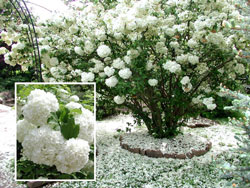Resource Library
Plant of the Week: Viburnum, Snowball
The University of Arkansas System Division of Agriculture does not promote, support or recommend plants featured in "Plant of the Week." Please consult your local Extension office for plants suitable for your region.
Plant of the Week
Snowball viburnum
Latin: Viburnum opulus 'Roseum'

Each generation of gardeners selects its own palate of plants considered indispensable for garden making. Some have a short shelf life and do not survive into another gardening era while others have staying power and remain commonplace centuries later. One of this latter group, the snowball viburnum (Viburnum opulus 'Roseum'), has been grown in gardens since at least the middle of the 16th century and is still commonplace in many gardens.
What are the characteristics of snowball viburnum?
Snowball viburnum is a multi-stemmed deciduous shrub with erect and then arching stems growing to 12 feet tall and wide. Unlike most viburnums, snowball has a distinctive three-lobed leaf almost reminiscent of a maple in outline. The leaves are to four inches long, rough textured, but unfortunately do not produce fall color.
Snowball is an apt name for this plant for the white clusters of blooms produced at the ends of the branches in mid-to-late spring are about the size and shape of their namesake. Each inflorescence is about three inches in diameter and consists of upwards of a hundred sterile flowers. The fertile form of the species, called the European cranberry bush, has bright red berries in a flat-topped panicle about four inches across.
The snowball viburnum in commerce is offered under the cultivar name 'Roseum,' a misleading name because the blooms are the purest white. It is said that sometimes the blooms will fade to a rose-tinged hue at the end of their two-week life span, but even this subtlety is hard to notice.
What are the origins of snowball viburnum?
Viburnum opulus is native throughout Europe. The sterile snowball form is thought to have originated in Holland. It was commonplace in gardens by the time Gerard wrote the first edition of his herb book in the closing years of the 16th century. He called the plant “Gelder Rose,” perhaps an adaptation of the Dutch name that was “Gheldersche Roosen.” The name “snowball” did not appear in print until about 1760.
Snowball viburnum was introduced into the United States during colonial times and has remained in production since then. The earliest iteration of the American nursery industry was, not surprisingly, in the northeastern states where most of the people lived. Only plants able to grow in an area with long, cold winters and capable of standing up to the rigors of long, slow transport were grown. Snowball viburnum fit the bill nicely.
What are the best uses for landscaping?
Spring blooming shrubs such as snowball all share one major flaw. They are one- shot wonders; they have a relatively short window of display and then fade into the background the rest of the year. And they are big, so they need lots of room. Snowball has traditionally been used as a stand-alone lawn specimen for screening or as part of the mixed shrub border. Today, dwarf versions of the snowball viburnum such as 'Compactum' (to 6 feet tall) and 'Nanum' (2 feet tall and 3 feet wide) make more sense in most landscape situations.
How do I care for snowball viburnum?
Like most viburnums, snowball should have six hours of full sun in order to flower best. It is tough and adaptable and will tolerate a wide array of soil types. Once established, it has great drought tolerance.
Aphids are a serious pest of new growth and cause much deformity of new leaves. But snowball viburnum is tough and, even if not controlled, aphids do not thwart the growth of this vigorous, easy-to-grow plant.
By: Gerald Klingaman, retired
Extension Horticulturist - Ornamentals
Extension News - April 11, 2008
The University of Arkansas System Division of Agriculture does not maintain lists of retail outlets where these plants can be purchased. Please check your local nursery or other retail outlets to ask about the availability of these plants for your growing area.